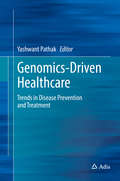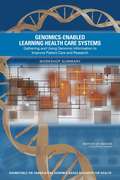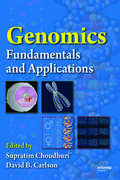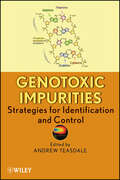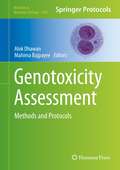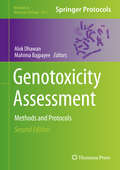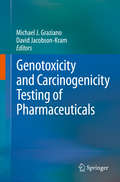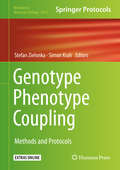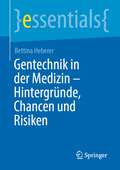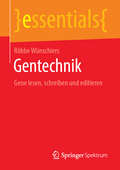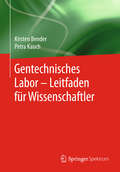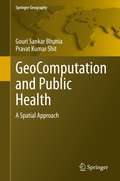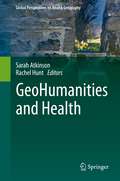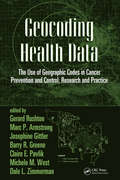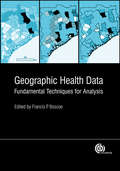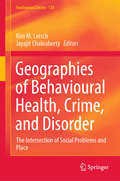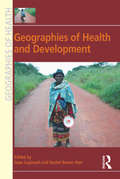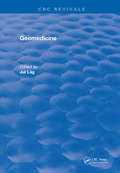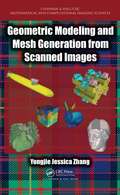- Table View
- List View
Genomics-Driven Healthcare: Trends in Disease Prevention and Treatment
by Yashwant PathakThis book evaluates trends arising in “-Omics” sciences in terms of their current and potential future application to therapeutic design and understanding of disease. Chapters consider the impact of pharmacogenomics and bioinformatics on drug development, as well as trends in genomics, as applied to understanding of neurodegenerative and lung disease, psychiatry and oncology.Following the genome studies released in early part of this century, the advent of the -Omics sciences (genomics and pharmacogenomics, proteomics, metabolomics, transcriptomics) has seen the expansion of a vast knowledgebase with utility in preventing and treating disease, and improving health for all. Bioinformatics and improved pharmacogenetic understanding forge a path for improved drug discovery and design methods accounting for differences in delivery and disposition across populations.
Genomics-Enabled Learning Health Care Systems: Workshop Summary
by Sarah H. BeachyThe inclusion of genomic data in a knowledge-generating health care system infrastructure is one promising way to harness the full potential of that information to provide better patient care. In such a system, clinical practice and research influence each other with the goal of improving the efficiency and effectiveness of disease prevention, diagnosis, and treatment. To examine pragmatic approaches to incorporating genomics in learning health care systems, the Institute of Medicine Roundtable on Translating Genomic-Based Research for Health hosted a workshop which convened a variety of stakeholder groups, including commercial developers, health information technology professionals, clinical providers, academic researchers, patient groups, and government and health system representatives, to present their perspectives and participate in discussions on maximizing the value that can be obtained from genomic information. The workshop examined how a variety of systems are capturing and making use of genomic data to generate knowledge for advancing health care in the 21st century. It also sought to evaluate the challenges, opportunities, and best practices for capturing or using genomic information in knowledge-generating health care systems. "Genomics-Enabled Learning Health Care Systems" summarizes the presentations and discussion of the workshop.
Genomics-Enabled Learning Health Care Systems: Workshop Summary
by Sarah H. BeachyThe inclusion of genomic data in a knowledge-generating health care system infrastructure is one promising way to harness the full potential of that information to provide better patient care. In such a system, clinical practice and research influence each other with the goal of improving the efficiency and effectiveness of disease prevention, diagnosis, and treatment. To examine pragmatic approaches to incorporating genomics in learning health care systems, the Institute of Medicine Roundtable on Translating Genomic-Based Research for Health hosted a workshop which convened a variety of stakeholder groups, including commercial developers, health information technology professionals, clinical providers, academic researchers, patient groups, and government and health system representatives, to present their perspectives and participate in discussions on maximizing the value that can be obtained from genomic information. The workshop examined how a variety of systems are capturing and making use of genomic data to generate knowledge for advancing health care in the 21st century. It also sought to evaluate the challenges, opportunities, and best practices for capturing or using genomic information in knowledge-generating health care systems. Genomics-Enabled Learning Health Care Systems summarizes the presentations and discussion of the workshop.
Genomics: Fundamentals and Applications
by Supratim Choudhuri David B. CarlsonThis unique new text delivers a solid foundation for understanding the role of genomics in human health and in advances that promise to help improve the quality of human life. Unlike other works that focus mainly on toxicogenomic techniques, Genomics presents a thorough overview of the field in four major sections: 1) fundamentals of genes and geno
Genotoxic Impurities
by Andrew TeasdaleThis book examines genotoxic impurities and their impact on the pharmaceutical industry. Specific sections examine this from both a toxicological and analytical perspective. Within these sections, the book defines appropriate strategies to both assess and ultimately control genotoxic impurities, thus aiding the reader to develop effective control measures. An opening section covers the development of guidelines and the threshold of toxicological concern (TTC) and is followed by a section on safety aspects, including safety tests in vivo and vitro, and data interpretation. The second section addresses the risk posed by genotoxic impurities from outside sources and from mutagens within DNA. In the final section, the book deals with the quality perspective of genotoxic impurities focused on two critical aspects, the first being the analysis and the second how to practically evaluate the impurities.
Genotoxicity Assessment: Methods and Protocols
by Mahima Bajpayee Alok DhawanGenetic toxicology is recognized by geneticists and researchers concerned with the genetic impact of man-made chemicals. In Genotoxicity Assessment: Methods and Protocols, expert researchers in the field provide comprehensive genetic toxicology protocols. These include in vitro and in vivo protocols on mutation assays, cytogenetic techniques, and primary DNA damage, assays in alternate to animal models, and updated ICH guidelines. Written in the highly successful Methods in Molecular Biology series format, the chapters include introductions to their respective topics, lists of the necessary materials and reagents, step-by-step and readily reproducible laboratory protocols, as well as key tips on troubleshooting and avoiding known pitfalls. Authoritative and cutting-edge, Genotoxicity Assessment: Methods and Protocols seeks to aid research students and scientists working in regulatory toxicology as well as biomedical, biochemical and pharmaceutical sciences.
Genotoxicity Assessment: Methods and Protocols (Methods in Molecular Biology #2031)
by Mahima Bajpayee Alok DhawanThis current edition explores new tests for genotoxicity testing, along with other well-known techniques. This will further help in our understanding of the genotoxic effects of chemicals. The book has different sections dealing with various assays for gene mutation, chromosomal abnormalities, primary DNA damage, etc. It also delves into plant models, animals and their alternates, as well as in silico approaches for genetic toxicology. Written for the highly successful Methods in Molecular Biology series, chapters include introductions to their respective topics, lists of the necessary materials and reagents, step-by-step, readily reproducible laboratory protocols, tips on troubleshooting and avoiding known pitfalls. Authoritative and up-to-date, Genotoxicity Assessment: Methods and Protocols, Second Edition serves as a highly useful and ready resource for research students and scientists working in regulatory toxicology as well as biomedical, biochemical, and pharmaceutical sciences.
Genotoxicity and Carcinogenicity Testing of Pharmaceuticals
by Michael J. Graziano David Jacobson-KramThis book provides an overview of the nonclinical testing strategies that are used to asses and de-risk the genotoxicity and carcinogenicity properties of human pharmaceuticals. It includes a review of relevant ICH guidelines, numerous case studies where follow-up studies were conducted to further investigate positive findings, and practical considerations for the use of alternative and emerging tests. With contributions from recognized experts in the pharmaceutical industry and health authorities, this volume presents a balanced view on the interpretation and application of genotoxicity and carcinogenicity regulatory guidances. Genotoxicity and Carcinogenicity Testing of Pharmaceuticals is a valuable resource for scientists, regulators, and consultants that are engaged in the conduct, reporting, and review of nonclinical studies. This book will also help academicians better understand and appreciate the complexity of the regulations and breadth of toxicology research that are necessary to support the development and marketing of new drugs.
Genotype Phenotype Coupling: Methods and Protocols (Methods in Molecular Biology #2070)
by Stefan Zielonka Simon KrahThis volume aims at providing state-of-the-art protocols detailing ribosome display, cDNA display, phage display, yeast surface display, and mammalian display. Chapters guide readers through methods and protocols on in vitro methods over prokaryotic display systems, lower eukaryotes, and mammalian cells. Written in the highly successful Methods in Molecular Biology series format, chapters include introductions to their respective topics, lists of all necessary materials and reagents, step-by-step, readily reproducible laboratory protocols, and key tips on troubleshooting and avoiding known pitfalls. Authoritative and cutting-edge, Genotype Phenotype Coupling aims to provide an overview of current technologies in this exciting and continuously evolving field.
Gentechnik in der Medizin – Hintergründe, Chancen und Risiken (essentials)
by Bettina HebererBettina Heberer gibt interessierten Laien einen Einblick in die Verwendung von Gentechnik in der Medizin. Die Autorin erläutert die verschiedenen Anwendungsbereiche der Gendiagnostik und Gentherapie. Zugelassene sowie potentielle zukünftige Therapiemöglichkeiten werden ebenso behandelt wie rechtliche Grundlagen. Eine Diskussion der Chancen und Risiken, die mit der Entwicklung neuer Technologien einhergehen, runden das Werk ab.
Gentechnik: Gene lesen, schreiben und editieren (essentials)
by Röbbe WünschiersDieses essential soll als Einführung für eine zeitgemäße öffentliche Diskussion zur Gentechnologie dienen. Die Gentechnik betrifft uns alle in vielen Bereichen und wir müssen uns trauen, bunter und weiter zu denken. Tatsächlich kann bereits das komplette Erbgut von Viren und Bakterien chemisch erzeugt und „zum Leben erweckt“ werden. Mit der Genchirurgie ist die Medizin an einem Scheidepunkt: Wollen wir Erbkrankheiten therapieren oder genetisch „reparieren“? Und die Analyse tausender menschlicher Erbgute fördert Informationen zutage, die mit komplexen Krankheiten, aber auch Merkmalen wie Intelligenz in Verbindung stehen. Wie sollen wir dieses Wissen nutzen? Es stellt sich kaum noch die Frage, ob wir Gentechnik wollen, sondern vielmehr, wie wir sie anwenden.
Gentechnisches Labor – Leitfaden für Wissenschaftler
by Kirsten Bender Petra KauchDieses Buch liefert Ihnen einen umfassenden und praxisnahen Überblick zu Fragen zum Gentechnikgesetz und seiner Rechtsverordnungen im Laboralltag. Ob Transformation bei Bakterien oder virale Gentransfermethoden bei höheren Zellen, die Kenntnis der rechtlichen Rahmenbedingungen und der Sicherheit in den Labors spielt bei allen angewandten Methoden die wichtigste Voraussetzung. Diese werden in Deutschland im Wesentlichen durch das Gentechnikgesetz und die Gentechnik-Sicherheitsverordnung gewährleistet. Worauf muss in der täglichen Praxis in einem „Genlabor“ geachtet werden? Wann haben Studenten, Doktoranden, technischen Mitarbeiter oder der Laborleiter die Verantwortung? Das neue Kompendium „Gentechnisches Labor - Leitfaden für Wissenschaftler“ unterstützt Studierende, Doktoranden, Wissenschaftler und Praktiker, aber auch die Laborleitung und den Betreiber in der Industrie bei der Anwendung der rechtlichen Vorgaben. Die wichtigsten gesetzlichen Vorgaben werden ausführlich einschließlich aktueller Bewertungen der ZKBS und aktueller Rechtsprechung dargestellt.
Gentle Healing for Baby and Child: A Parent's Guide to Child-Friendly Herbs and Other
by Andrea CandeeGive your child the gift of natural healthWhen your children are sick or injured, you want them to feel better -- fast. Although in some cases there is no substitute for traditional medical care, prescription drugs are not always the best answer. Countless parents are discovering that natural, health-promoting substances can often be both safer and more effective. Now, a master herbalist with more than twenty-five years of experience who is also a mother of two shares her natural approach to wellness. Inside you'll find easy holistic therapies for common childhood injuries and ailments, and learn: how a banana can remove a splinter which herbs help reduce fever how an onion helps both bruises and earaches why garlic is nature's antibiotic how a spritz of rosemary hair juice prevents lice why peppermint tea relieves both headaches and stomachaches how gargling with lemon juice and table salt can ease a sore throat why ginger root can ease motion sickness and many other intelligent uses of foods and therapeutic plants -- nature's own medicine -- to alleviate discomforts.Best of all, this invaluable reference stresses and approach that helps you teach you children the benefits of proventing illness -- not just treating it.
Geo-Spatial Analysis of Forest Landscape for Wildlife Management (GIScience and Geo-environmental Modelling)
by Nilanjana Das Chatterjee Mrinmay MandalThis book presents research on landscape ecology and the relationship between humans and wildlife. It helps readers understand how ecological patterns and processes are interconnected. This research illustrates and proposes (practicable) management strategies toward long-term ecological restoration and mitigation of consequences of conflict. Increasing wildlife activities in localities and forest fringes are an alarming issue. Ecological processes like movement, colonization, extinction and conflict issues depend on the landscape and ecological activities, the movement for example of migratory elephants and their colonization not only affects society but the wildlife and biodiversity too. Strategic management measures can contribute to enriching the biodiversity, habitat quality as well as landscape, while minimizing human-wildlife conflicts. This book describes landscape ecological patterns and processes, habitat dominancy, habitat dependency, suitability, connectivity and corridor selection. To synthesize these patterns and processes, several ecological indices are used. Use of geo-spatial techniques improves future management strategies for similar circumstances, especially, related to forest regeneration and forest restoration. This book provides a concise overview to a wide range of readers including postgraduate students, researcher, academics, landscape planners, decision makers and even local populations. The techniques and management strategies described should help planners to improve forest management, by implementing quality enhancement programs such as plantation area selection and corridor selection.
GeoComputation and Public Health: A Spatial Approach (Springer Geography)
by Gouri Sankar Bhunia Pravat Kumar ShitGeoComputation and Public Health is fundamentally a multi-disciplinary book, which presents an overview and case studies to exemplify numerous methods and solicitations in addressing vectors borne diseases (e.g, Visceral leishmaniasis, Malaria, Filaria). This book includes a practical coverage of the use of spatial analysis techniques in vector-borne disease using open source software solutions. Environmental factors (relief characters, climatology, ecology, vegetation, water bodies etc.) and socio-economic issues (housing type & pattern, education level, economic status, income level, domestics’ animals, census data, etc) are investigated at micro -level and large scale in addressing the various vector-borne disease. This book will also generate a framework for interdisciplinary discussion, latest innovations, and discoveries on public health. The first section of the book highlights the basic and principal aspects of advanced computational practices. Other sections of the book contain geo-simulation, agent-based modeling, spatio-temporal analysis, geospatial data mining, various geocomputational applications, accuracy and uncertainty of geospatial models, applications in environmental, ecological, and biological modeling and analysis in public health research. This book will be useful to the postgraduate students of geography, remote sensing, ecology, environmental sciences and research scholars, along with health professionals looking to solve grand challenges and management on public health.
GeoHumanities and Health (Global Perspectives on Health Geography)
by Sarah Atkinson Rachel HuntThis volume brings together research in the GeoHumanities from various intellectual perspectives to illustrate the benefits of humanities-inspired approaches in understanding and confronting historically entrenched and recently emergent health-related challenges. In three main sections, this volume seeks to foreground the richness of work entangling medicine and health with the concerns of geography and of the Humanities. This volume will be of interest to academics and researchers in the Geographies of health and medicine, social sciences in GeoHumanities, and health humanities, and students in programs focusing on the humanities and health. In the book's first section, Bodies, the authors explore the material, sensory and more than physical capacities of bodies in accounting for experiences of death, air raids, immigration, dance therapy, asthma and blindness. Section two, Voice, addresses the nature of evidence, HIV/AIDS policy, patient voices in animal research, homelessness, and constructions of truth. The final section, Practice, focuses on creative writing, as well as the pedagogic tools of teaching with the asylum, the creative practice of nuclear emergency planning zones, arts-based care for the elderly, and cartographic practices within health research.
Geocoding Health Data: The Use of Geographic Codes in Cancer Prevention and Control, Research and Practice
by Dale L. Zimmerman Gerard Rushton Marc P. Armstrong Josephine Gittler Barry R. Greene Claire E. Pavlik Michele M. WestIn the past, disease pattern mapping depended on census tracts based on political units, such as states and counties. However, with the advent of geographic information systems (GIS), researchers can now achieve a new level of precision and flexibility in geographic locating. This emerging technology allows the mapping of many different kinds of ge
Geographic Adjustment in Medicare Payment
by Committee on Geographic Adjustment Factors in Medicare PaymentMedicare is the largest health insurer in the United States, providing coverage for 39 million people aged 65 and older and 8 million people with disabilities, and reaching more than an estimated $500 billion in payments in 2010. Although Medicare is a national program, it adjusts fee-for-service payments according to the geographic location of a practice. While there is widespread agreement about the importance of providing accurate payments to providers, there is disagreement about how best to adjust payment based on geographic location. At the request of Congress and the Department of Health and Human Services (HHS), the Institute of Medicine (IOM) examined ways to improve the accuracy of data sources and methods used for making the geographic adjustments to payments. The IOM recommends an integrated approach that includes moving to a single source of wage and benefits data; changing to one set of payment areas; and expanding the range of occupations included in the index calculations. The first of two reports, Geographic Adjustment in Medicare Payment: Phase I: Improving Accuracy, assesses existing practices in regards to accuracy, criteria consistency, evidence for adjustment, sound rationale, transparency, and separate policy adjustments to reform the current payment system. Adopting the recommendations outlined in this report will mean a change in the way that the indexes are calculated, and will require a combination of legislative, rule-making, and administrative actions, as well as a period of public comment. Geographic Adjustment in Medicare Payment will inform the work of government agencies such as HHS, the Centers for Medicare and Medicaid Services, congressional members and staff, the health care industry, national professional organizations and state medical and nursing societies, and Medicare advocacy groups.
Geographic Adjustment in Medicare Payment: Phase II
by Institute of Medicine Frank A. Sloan Board on Health Care Services A. Bruce Steinwald Margaret Edmunds Committee on Geographic Adjustment Factors in Medicare PaymentMedicare, the world's single largest health insurance program, covers more than 47 million Americans. Although it is a national program, it adjusts payments to hospitals and health care practitioners according to the geographic location in which they provide service, acknowledging that the cost of doing business varies around the country. Under the adjustment systems, payments in high-cost areas are increased relative to the national average, and payments in low-cost areas are reduced. In July 2010, the Department of Health and Human Services, which oversees Medicare, commissioned the IOM to conduct a two-part study to recommend corrections of inaccuracies and inequities in geographic adjustments to Medicare payments. The first report examined the data sources and methods used to adjust payments, and recommended a number of changes. Geographic Adjustment in Medicare Payment - Phase II:Implications for Access, Quality, and Efficiency applies the first report's recommendations in order to determine their potential effect on Medicare payments to hospitals and clinical practitioners. This report also offers recommendations to improve access to efficient and appropriate levels of care. Geographic Adjustment in Medicare Payment - Phase II:Implications for Access, Quality, and Efficiency expresses the importance of ensuring the availability of a sufficient health care workforce to serve all beneficiaries, regardless of where they live.
Geographic Health Data
by Tarek Rashed Daniel Goldberg Andrew Curtis Francis Boscoe Nathaniel Bell Jarvis Chen Christopher Saarnak Jin Chen Chetan Tiwari Kevin HenryFocussing on proven techniques for most real-world data sets, this book presents an overview of the analysis of health data involving a geographic component, in a way that is accessible to any health scientist or student comfortable with large data sets and basic statistics, but not necessarily with any specialized training in geographic information systems (GIS). Providing clear, straightforward explanations with worldwide examples and solutions, the book describes applications of GIS in disaster response.
Geographic Health Data: Fundamental Techniques for Analysis
by Tarek Rashed Daniel Goldberg Andrew Curtis Nathaniel Bell Jarvis Chen Christopher Saarnak Jin Chen Chetan Tiwari Kevin HenryFocussing on proven techniques for most real-world data sets, this book presents an overview of the analysis of health data involving a geographic component, in a way that is accessible to any health scientist or student comfortable with large data sets and basic statistics, but not necessarily with any specialized training in geographic information systems (GIS). Providing clear, straightforward explanations with worldwide examples and solutions, the book describes applications of GIS in disaster response.
Geographies of Behavioural Health, Crime, and Disorder: The Intersection of Social Problems and Place (GeoJournal Library #126)
by Jayajit Chakraborty Kim M. LerschThis book focuses on the intersection of place and overall community health thereby focusing on some of the most critical contemporary social problems, including the opioid crisis, suicide, socioeconomic status and ethnicity, mental illness, crime, homelessness, green criminology, and social and environmental justice. Scholars from a variety of disciplines, including geography, sociology, criminology, mental health, social work, and behavioural sciences discuss the importance of geography in our quality of life. Each chapter introduces the reader to an overview of the topic, presents theoretical frameworks and the most recent empirical evidence, and discusses real world policy implications. As such this book is a key resource for researchers, policy makers, and practitioners working in the field.
Geographies of Health and Development (Geographies of Health Series)
by Rachel Bezner Kerr Isaac LuginaahThe geographies of health and development is an emerging sub-discipline, tying in with many of the conceptual, theoretical and practical components of other disciplines working in health, health care, economics, and international development. Spatially and theoretically grounded in geography, this collection offers a fresh perspective on the dialectic relationships between health and development. Health problems in a developing context take on much higher rates of prevalence as a result of the varied cultural, structural and economic vulnerabilities of the people they impact. This book begins by exploring some of the circumstances surrounding the distinctive health inequities currently facing many developing countries, including malaria, maternal mortality and HIV/AIDS. This is followed by a discussion of how matters of physical access and human resource issues and, perhaps most importantly, the challenges of financing, together shape the access and utilization of health care. Examining how the environment interacts to influence the health of the people that live there, the next section includes discussion around challenges of food (in)security, and the importance of clean and uncontaminated water for health. Finally, the book explores the influence of globalization on health, specifically within the urban environment, against the backdrop of global health policy.
Geomedicine (CRC Press Revivals)
by Jul LagThis fascinating work features such topics as the relationships between iodine deficiency and goiter, fluorine deficiency and caries, selenium deficiency and muscular degeneration, mercury surplus and specific nerve diseases, cadmium surplus and kidney failure. This one-of-a-kind volume reveals discoveries which may be of importance in future preventive medicine for man and animals. It shows that the comprehensive progress in chemical analyses has established a valuable basis for determining many environmental features and for the foundation of modern geomedicine. Those involved with geology, soil science, nutrition, biology, veterinary sciences, and prophylactic socio-medical sciences will find this resource indispensable.
Geometric Modeling and Mesh Generation from Scanned Images (Chapman & Hall/CRC Mathematical and Computational Imaging Sciences Series #6)
by Yongjie Jessica ZhangCutting-Edge Techniques to Better Analyze and Predict Complex Physical Phenomena Geometric Modeling and Mesh Generation from Scanned Images shows how to integrate image processing, geometric modeling, and mesh generation with the finite element method (FEM) to solve problems in computational biology, medicine, materials science, and engineering. Based on the author’s recent research and course at Carnegie Mellon University, the text explains the fundamentals of medical imaging, image processing, computational geometry, mesh generation, visualization, and finite element analysis. It also explores novel and advanced applications in computational biology, medicine, materials science, and other engineering areas. One of the first to cover this emerging interdisciplinary field, the book addresses biomedical/material imaging, image processing, geometric modeling and visualization, FEM, and biomedical and engineering applications. It introduces image-mesh-simulation pipelines, reviews numerical methods used in various modules of the pipelines, and discusses several scanning techniques, including ones to probe polycrystalline materials. The book next presents the fundamentals of geometric modeling and computer graphics, geometric objects and transformations, and curves and surfaces as well as two isocontouring methods: marching cubes and dual contouring. It then describes various triangular/tetrahedral and quadrilateral/hexahedral mesh generation techniques. The book also discusses volumetric T-spline modeling for isogeometric analysis (IGA) and introduces some new developments of FEM in recent years with applications.
